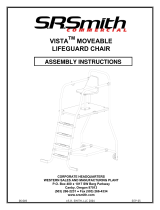Page is loading ...

06-824 MAR17
42” SENTRY LIFEGUARD STAND
ASSEMBLY AND INSTALLATION
INSTRUCTIONS
SRS AUSTRALIA, PTY LTD
12 Enterprise St
Richlands QLD 4077
Australia
Phone 07 3812 2283 • Fax 07 3812 1187
www.srsmith.com/au
S.R. SMITH, LLC
CORPORATE HEADQUARTERS
P.O. Box 400 • 1017 S.W. Berg Parkway
Canby, Oregon 97013
USA
Phone (503) 266 2231 • Fax (503) 266 4334
www.srsmith.com

2
TABLE OF CONTENTS
INTRODUCTION ....................................................................................................................... 3
INSTALLED LIFEGUARD STAND STRUCTURAL & INSTALLATION CHECKLIST .................. 3
MAINTENANCE INSTRUCTIONS ............................................................................................. 3
ASSEMBLED LIFEGUARD STAND LAYOUT ............................................................................ 4
PARTS LIST .............................................................................................................................. 5
Tools Required ..................................................................................................................... 7
Lifeguard Stand Assembly ...................................................................................................... 7

3
INTRODUCTION
DANGER – FAILURE TO FOLLOW THESE WARNINGS, INSTRUCTIONS, AND THE
OWNER’S MANUAL MAY RESULT IN SERIOUS INJURY.
PROPER ASSEMBLY, INSTALLATION, USE, AND SUPERVISION ARE ESSENTIAL FOR PROPER
OPERATION AND TO REDUCE THE RISK OF SERIOUS INJURY.
CHECK INSIDE ALL BOXES AND PACKAGING MATERIALS FOR PARTS. BEFORE BEGINNING
ASSEMBLY, READ ALL INSTRUCTIONS AND IDENTIFY PARTS USING THE FIGURES AND PARTS
LISTED IN THIS DOCUMENT. IT IS CRITICAL THAT ALL PARTS BE CAREFULLY INSPECTED BY
THE INSTALLER PRIOR TO INSTALLATION TO ENSURE THAT NO DAMAGE OCCURRED IN
TRANSIT AND THAT A DAMAGED PART IS NOT USED. PROPER INSTALLATION CANNOT BE
OVERSTRESSED, IMPROPER INSTALLATION VOIDS S.R. SMITH’S WARRANTY AND MAY
AFFECT THE SAFETY OF THE USER.
INSTALLED LIFEGUARD STAND STRUCTURAL & INSTALLATION CHECKLIST
1. Inspect material for visible cracks or damage.
2. Inspect hardware for missing or damaged parts.
3. Inspect all fasteners to make sure they are fully tightened.
4. Inspect the Lifeguard Stand for rigidity (and attachment if using anchors).
MAINTENANCE INSTRUCTIONS
1. When hosing down the deck, hose your Lifeguard Stand to wash away any dust, dirt or other debris,
which may have accumulated and wipe clean.
2. Be sure that all connections are secure. Tighten hardware if necessary and check for corroded
fasteners.
3. Inspect for visible cracks or other damage.
4. Inspect all parts for evidence of shear, bending yield, or fatigue. Yield is evidenced by discoloration
or fine cracking of the surface.

4
ASSEMBLED LIFEGUARD STAND LAYOUT

5
PARTS LIST
Item #
Part #
Description
Qty.
1
03-500
FOOTREST & STEP, TOP
2
2
03-501
SEAT & BACK PLATE
2
3
03-502
SEAT SUPPORT, SIDE
2
4
03-503
SEAT SUPPORT, REAR
1
5
03-504
SEAT SUPPORT, CENTER
1
6
03-505
SEAT SUPPORT, FRONT
1
7
03-506
BACK SUPPORT, RIGHT
1
8
03-507
BACK SUPPORT, LEFT
1
13
03-512
42" FRONT LEG, RIGHT
1
14
03-513
42" FRONT LEG, LEFT
1
15
03-514
42" REAR LEG, RIGHT
1
16
03-515
42" REAR LEG, LEFT
1
17
03-516
FOOTREST, FRONT
2
21
03-520
42" FOOTREST SIDE, RIGHT
1
22
03-521
42" FOOTREST SIDE, LEFT
1
23
03-522
42" STEP, SIDE
2
24
03-523
42" CROSSBRACE, STRAIGHT
2
25
03-524A
42" CROSSBRACE A, ANGLED
1
26
03-524B
42" CROSSBRACE B, ANGLED
1
27
03-525
CUP HOLDER
1
28
03-526
UMBRELLA MOUNT
1
29
03-527
42" BASE, FRONT
1
30
03-528
42" BASE, REAR
1
31
03-529
ARM REST, LEFT
1
32
03-530
ARM REST, RIGHT
1
Hardware
42"
Chair
34
05-33-121
#8 X 2" SCREW, #2 SQUARE DRIVE, 316SS
66
35
05-33-123
1/4-20 NYLON-INSERT LOCKNUT, 316SS
34
36
05-33-124
1/4 FLAT WASHER, 316SS
34
37
05-33-125
1/4-20 X 2.25” FLAT HEAD HEX DRIVE SCREW, 316SS
34
38
05-33-126
1/4-20 X 1.75" PLASTIC ROSETTE HEAD THUMB SCREW,
316SS
1

6
Visit srsmith.com for hardware kit and replacement part information.

7
ASSEMBLY INSTRUCTIONS
Tools Required
1. #2 Square Drive Bit
2. 5/32” Allen Wrench
3. 7/16” Ratchet or Wrench
Lifeguard Stand Assembly
1.Attach part (2) to part (3) as shown using screws (34).
2.Attach part (3) to assembly using screws (34).

8
3.Attach part (4) to assembly with screws (34).
4.Attach part (5) with notch in direction shown to assembly using screws (34).
5.Attach part (6) to assembly with screws (34).

9
6.Seat Bottom Assembly should look like the pictures below when finished. Next make Seat
Back Assembly.
7.Attach part (2) to part (8) using screws (34).
8.Attach part (7) to assembly using screws (34).

10
9.Seat Back Assembly should look like the pictures below when finished. Next make
Footrest Assembly.
10.Attach part (21) to part (1) using screws (34).
11.Attach part (22) to assembly using screw (34).
12.Attach part (17) to assembly using screws (34).

11
13.Finished Footrest Assembly should look like the picture below. Next attach legs using
last 3 assemblies.
14.Attach Seat Back Assembly, Seat Bottom Assembly, and Footrest Assembly to leg (15)
as shown using nuts (35), washers (36), and screws (37).

12
15.Next, attach leg (13) to assembly using nuts (35), washers (36), and screws (37).
16.Attach step side (23) to assembly using nuts (35), washers (36), and screws (37).

13
17.Now flip the chair over and attach leg (16) to assembly using nuts (35), washers (36),
and screws (37).
18.Now attach front base (29) to assembly using screws (34).

14
19.Attach leg (14) to assembly with nuts (35), washers (36), and screws (34 & 37).
20.Now install the other step side (23) using nuts (35), washers (36), and screws (37).

15
21.Next install the top step (1) using screws (34).
22.Attach footrest front (17) using screws (34).

16
23.Attach arm rest (31) using screws (34).
24.Attach arm rest (32) using screws (34).

17
25.Attach braces (24) using screws (34).
26.Attach cross braces (25 & 26) using nuts (35), washers (36), and screws (33).

18
27.Attach cup holder (27) using screws (34).
28.Attach umbrella mount (28) using screws (34).

19
29.Assembly complete. Now, go back through assembly to ensure all hardware has been
properly tightened.
Warning: Chair required to be anchored to deck when using umbrella.
Recommended Anchor: When installing in concrete use type 316 stainless steel concrete anchor,
3/8” in diameter (not included)

A
/









